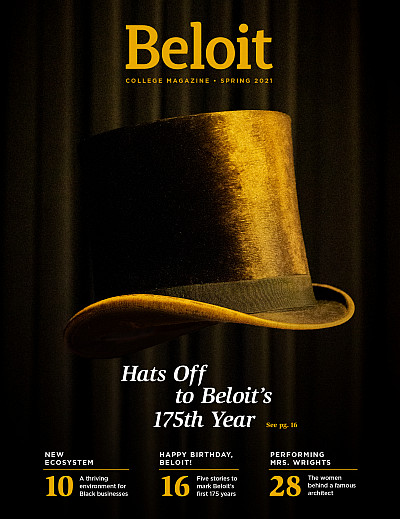A Brief History of Women at Beloit
Beloit took its sweet time when it came to admitting women to the college. In fact, the campus was a man’s world until trustees voted in 1895 to admit women ‘quietly and without ado.’
This may come as a surprise to some. When Beloit was founded in 1846, it was a traditional college of its time with explicit Christian roots, and it was exclusively for men.
In its 175 years of existence, Beloit has earned a reputation for progressiveness, but the college was surprisingly slow to embrace a growing trend of coeducation in the late 1800s. The decision about allowing women into Beloit was fraught and continued for years. For nearly its first five decades, Beloit remained open only to men.
Coeducation was a hot topic nationally in the last half of the 19th century, and it was fiercely debated at Beloit. In the Round Table and from podiums across campus and beyond, students, faculty, alumni, even the college president, passionately argued the pros and cons of educating men alongside women.
By the time Beloit approached its 25th anniversary, the tradition of separate social spheres for women and men in the wider world was breaking down, and universities were moving toward coeducation.
In 1894, Edward Dwight Eaton, Beloit’s second president, remained strongly opposed to a coed college. He wrote that if it were up to him, he would “never, never, never let women come in,” but he added a caveat: “He was willing if the trustees wanted it.”
Overwhelmingly, the faculty wanted to admit women, and so did the trustees, who saw their enrollment as a wise financial decision and a move to keep Beloit in step with the times.
With the decision finally made, Beloit’s first cohort of 33 women started in the fall of 1895, the conflict over their admittance still fresh.
Grace Chamberlin Rosa (1898) spoke many years later that in her first year, male students would sometimes slam doors in women’s faces or place their feet on women’s chairs or desks.
But the childish hostility did not last. By Thanksgiving of the first coed fall, one Round Table article gave thanks for “… one of [the] greatest experiments, co-education. … It has been tested here and has proven a booming success …”
Beloit women earned respect by proving they were capable scholars. They took the same courses as men (except for physical education), supported existing social traditions, and started popular new ones, including founding a Shakespeare Society with women playing all the roles.
They also rocked the boat. In 1896, seven women students started showing up around campus wearing Theta Pi Gamma pins, indicating membership in a secret society, since sororities were forbidden and forced underground. A succession of Beloit’s women students would keep pushing for Theta’s acceptance until they were finally allowed a local chapter in 1908.
Mostly, Beloit’s earliest women students silenced any remaining critics with their grades. By 1901, only six years after women were first admitted, the salutatorian and valedictorian of Beloit’s graduating class were both women.
Three Women to Know
Grace Ousley (1904)

Lorine Niedecker (1926)

Martha Peterson

Rooms of Their Own

The physical spaces connected to Beloit women have their own dramatic stories, surviving fires and near demolitions (Emerson Hall), and serving as bases for activism, community, and support over more than 125 years.
These places range from a handful of frame cottages, the first women’s residences on the north end of campus, to the eclectic, castle-like Emerson Hall. Opened to students in 1898, Emerson was exclusively for women and funded by the wealthy donor D.K. Pearsons at the behest of his wife, after she and her sister convinced him of coeducation’s merits.
Until it turned co-ed in 1971, Emerson was the domain of women and originally featured its own dining hall, gymnasium, and maid service—all for $1 per week (plus board) when it opened.

In 1974, the Sisterhood was the force behind opening the first Women’s Center on Church Street. Members produced Lilith’s Daughter, a creative writing journal through the 1980s-90s, and presented programming that raised awareness of issues such as sexual assault.
The Women’s Center later moved a block north to where it stands today as the Feminist Collective, or FemCo, a special interest student residence and gathering place that retains its strong sense of community.





